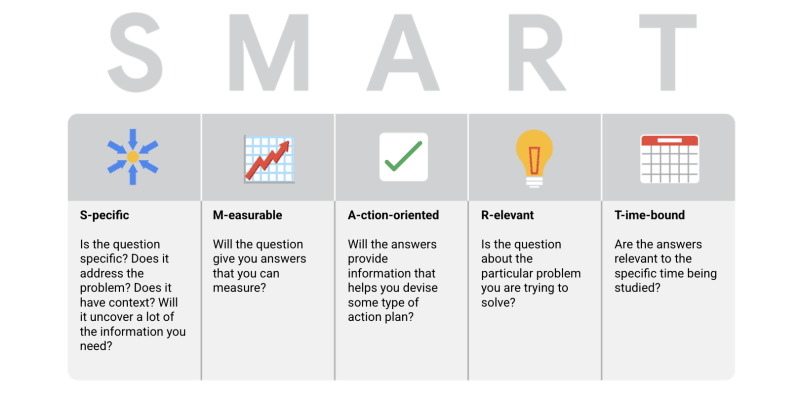Introduction
As a data analyst, solving and providing data-driven solutions to problems is at the heart of what you do every day. These problems can be tiny or vast, simple or complicated; no problem is the same, and each requires a somewhat different strategy; yet, the first line of action in the data analysis phases is always the same: "Ask." In this article, you are going to learn how to ask effective and SMART questions to help you define the problem you're solving and make sure that you fully understand expectations.
Some Guiding Tips And Questions.
Here are a few guiding tips and questions to always consider:
Who are the stakeholders? Ascertain that you completely understand their expectations.
Define the issue(s) you are attempting to address with your analysis.
How accurate and reliable is my data? According to studies, incorrect data costs businesses 15% of their income and wastes 40% of analysts's time.
What measures and key performance indicators will you employ to assess your data, achieve your objectives, and determine success?
How can this data provide actionable insights and assist stakeholders in making decisions?
What is the full picture? Do you have other critical data points to give context to the rest of your data set?
Here, Dennis wrote more about some of these guiding tips and questions.
A framework for asking effective questions
The SMART framework ensures that our queries are clear, quantitative, actionable, topical, time-constrained, feasible, and connected with the business objectives. It helps streamline the data analytics ask phase, develop a precision culture, and leverage the power of data to unleash important data-driven insights and contribute to business success.
Specific
Specific questions are straightforward and narrowly focused on gathering information pertinent to the problem to be solved. This aids in the collection of information relevant to the subject at hand.
- An example: What specific variables should we examine when evaluating the performance of our marketing campaigns?
Measurable
Quantifiable questions can be measured and evaluated. Asking measurable questions is critical for defining clear, quantifiable goals and successfully tracking progress. By asking questions that can be specifically quantified, such as in terms of numerical values, percentages, or specified units, they can help us create reasonable goals and provide the benchmarks we need to evaluate the performance of our data analytics initiatives, ensuring that our efforts produce concrete and quantifiable results.
Tip: Before you ask your questions, are you able to measure the answers?
An example: How many new leads can we produce in the next quarter by implementing our data-driven marketing strategy?
Action
Action-oriented questions accelerate the implementation of data-driven plans and initiatives by framing questions that stress concrete actions and solutions.
Tip: Before you ask the question: Will the questions lead you to devise some type of action plan?
An example: What concrete efforts can we take over the next six months to improve our data processing pipeline and reduce processing time by 20%?
Relevant
Relevant questions ensure that your analytical efforts directly contribute to resolving the issues you are tackling by developing queries that are tightly related to the problem you are solving. It is critical to concentrate on questions that will have a direct influence on the issue to be solved, unlike irrelevant inquiries that might waste time and resources.
Tip: Before you ask a question, evaluate how relevant it is to the particular problem you are trying to solve.
An example: Given the rising global market rivalry and the requirement for operational efficiency, how can we utilize data analytics to improve our supply chain management and eliminate needless expenditures without sacrificing product quality?
Time
Time-based questions often focus on establishing deadlines and timelines for attaining specified goals or milestones within a defined period. These questions are critical for instilling urgency and responsibility in the data analytics process.
- For example, instead of asking "How can we increase customer retention?", you might ask, "How can we increase customer retention by 15% in the next two months by using social media ads?
By concentrating on these essential factors, you'll be better prepared to meet the problems you'll face as a data analyst and ensure you're asking the correct questions to achieve success.
Mistakes to avoid
leading questions: questions that only have or suggest a particular response.
Example: Most people find our new feature very useful, don't they? Instead, ask: What has been your experience with our new feature so far?
Closed-ended questions: questions that ask for a one-word or brief response only
Example: Were you satisfied with the customer engagement on our pages? Instead, ask: What is your opinion of the customer engagement on our pages?
Vague questions: questions that aren’t specific or don’t provide context.
Example: Does the tool simplify your tasks? Instead, ask: How has the tool impacted the speed of your data visualization tasks?
Conclusion
SMART Questions: Ensure your questions are:
Specific: Clearly define the problem.
Measurable: Quantify the problem or goal.
Action-oriented: Focus on steps to resolve the issue.
Relevant: Relate to the project’s overall objectives.
Time-bound: Set a timeline for achieving the goal.
Things to avoid when asking questions:
Leading questions: Avoid biasing the respondent’s answer.
Closed questions: Allow room for open-ended responses.
Vague questions: Clearly state what you want to know.
Credits
image credit: Artem Maltsev on Unsplash




Top comments (0)